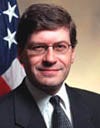Senate Flip Dooms D.C. Circuit Nominee Peter Keisler
Republicans fail to expedite confirmation to key seat
Never take a Senate majority for granted.
When George W. Bush appointed Brett Kavanaugh to the D.C. Circuit at the end of May 2006, Kavanaugh filled the tenth seat on that court. So Bush had one more vacancy to fill, apart from the controversial twelfth seat.
One month later, Bush nominated the outstanding lawyer Peter Keisler. Republicans had a comfortable 55 seats in the Senate. Upon his confirmation and appointment, Keisler would become the eighth Republican appointee on the D.C. Circuit, versus only three Democratic appointees.
But Republicans would fail to confirm Keisler’s nomination before the November 2006 elections, and those elections would swing control of the Senate back to Democrats. Keisler’s nomination would languish in limbo through 2007 and 2008.
***
In an increasingly polarized legal environment, Peter Keisler had earned widespread respect, winning, as the Washington Post editorial board would put it, “plaudits from the right and left for his stellar intellect and his judicial demeanor.” A former law clerk to Supreme Court justice Anthony Kennedy and to D.C. Circuit judge Robert Bork, Keisler had extensive experience in the executive branch, first in the White House counsel’s office under Ronald Reagan and then in senior positions in the Department of Justice under George W. Bush. He also had been a top-notch appellate partner with the law firm of Sidley Austin.
On top of his excellent credentials, Keisler would acquire the unenviable distinction of being blocked for seats on two different court of appeals. Back at the outset of his presidency in 2001, Bush had hoped to nominate Keisler to a putative Maryland seat on the Fourth Circuit. (I say putative because it is Senate practice, not law, that associates a seat within a circuit with a particular state.) But Maryland’s two Democratic senators, Paul Sarbanes and Barbara Mikulski, objected to Keisler, purportedly on the ground that the longtime resident of a Maryland suburb of Washington, D.C. did not have sufficient civic ties to the state. Their refusal to return positive blue slips on his nomination doomed his candidacy.
Because the District of Columbia doesn’t have senators, Bush and Keisler didn’t have to worry about blue slips when Bush picked Keisler for the D.C. Circuit in 2006. But that also meant that Keisler didn’t have any home-state senators who would press to get him confirmed quickly.
Senate Judiciary Committee chairman Arlen Specter moved expeditiously to schedule a hearing on Keisler’s nomination. Keisler’s hearing took place on August 1, 2006, less than five weeks after Bush nominated him. Democratic senator Chuck Schumer complained that “we are having this hearing with astonishing and inexplicable speed.” He also invoked statements by Republican senators during Bill Clinton’s presidency that objected even to filling the D.C. Circuit’s eleventh seat.
Schumer himself had no objection to filling the D.C. Circuit’s eleventh seat. Indeed, he and many of his fellow Democrats had voted barely a year earlier to confirm Thomas Griffith to what was then the eleventh seat. But with Senate elections barely three months away, Schumer was looking to slow down Keisler’s confirmation.
The calendar conspired with Schumer. The Senate went into recess two days after Keisler’s hearing, and it did not reconvene until September. For reasons that are inscrutable, the Judiciary Committee failed to report Keisler’s nomination to the Senate floor during all of September. The Senate then recessed for all of October and through the November elections.
In those November elections, Republicans managed to lose six seats—including three very close races in Missouri, Montana, and Virginia—and their Senate majority.
Senate Republicans made no effort to confirm Keisler’s nomination in the lame-duck session before the newly constituted Senate convened in January 2007.
***
Bush renominated Keisler in 2007 to a Senate in which Democrats, together with independents Joseph Lieberman and Bernie Sanders, had 51 seats. The Washington Post and Los Angeles Times editorial boards urged Senate Democrats to confirm Keisler, but to no avail.
Keisler would end up serving a stint as acting Attorney General in 2007 before returning to private practice.
***
In hindsight, it’s fair to wonder why the White House took so long to nominate Keisler. Judge Harry Edwards had announced in June 2005 that he would take senior status in November 2005, so when John Roberts was successfully elevated to the Supreme Court in late September 2005, the White House knew that the eleventh seat would soon be available.
One part of the answer is that the White House lawyers were swamped through January 2006 with work on Harriet Miers’s failed nomination to the Supreme Court and then on Samuel Alito’s nomination.
Another part of the answer is that Republicans on the Judiciary Committee had discouraged the White House from making a nomination while Kavanaugh’s hotly contested nomination was still pending. Bush didn’t want to do anything that might jeopardize Kavanaugh’s nomination. Senate Democrats had already shown themselves happy to allow one nominee (Griffith) to leapfrog over Kavanaugh, and Bush didn’t want to give them another opportunity.
***
Republican senators didn’t make it a high priority to confirm Keisler when they had the opportunity to do so. No one in a Senate majority should assume that majority will survive the next election.



